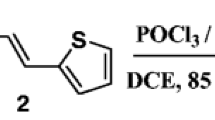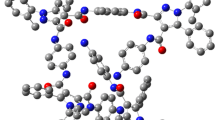Abstract
Polymers and low-molar-mass-compounds containing donor and acceptor moieties are recently of great interest for the application in organic light-emitting diodes and other optoelectronic devices. Here, we report on the synthesis of oligomers containing carbazole or triphenylamine units as donors and thiazolo[5,4-d]thiazole as an acceptor moiety and on the corresponding low-molar-mass model compounds. In order to control the molecular weights and solubility of oligomeric compounds obtained via condensation reaction, the different ratios of mono- and diformyl derivatives were chosen. Thermal, optical, photophysical and electrochemical properties of the synthesized compounds were investigated. The initial thermal decomposition temperatures of the synthesized oligomeric compounds were in the range of 218–289 °C. Glass transition temperatures of the synthesized oligomeric compounds ranged from 109 to 174 °C. They absorb light in the range of 402–442 nm and emit in the region from 472 to 533 nm. The ionization potential values of the synthesized compounds ranged from 5.29 to 5.48 eV as it was established by cyclic voltammetry. Relatively wide ranges of the characteristics obtained show that purposeful manipulation of the conditions of the synthesis of the donor disubstituted thiazolo[5,4-d]thiazoles can lead to the preparation of the electroactive compounds with the desired sets of the properties.






Similar content being viewed by others
References
Abbaszadeh D, Blom PWM (2016) Efficient blue polymer light-emitting diodes with electron-dominated transport due to trap dilution. Adv Electron Mater 2:1500406. https://doi.org/10.1002/aelm.201500406
Wei C, Tang Z, Zhang W, Huang J, Zhou Y, Wang L, Yu G (2020) Molecular engineering of (E)-1,2-bis(3-cyanothiophene-2-yl)ethene-based polymeric semiconductors for unipolar n-channel field-effect transistors. Polym Chem 11:7340–7348. https://doi.org/10.1039/D0PY01399D
Max JB, Nabiyan A, Eichhorn J, Schacher FH (2021) Triple-responsive polyampholytic graft copolymers as smart sensors with varying output. Macromol Rapid Commun 42:2000671. https://doi.org/10.1002/marc.202000671
Lv L, Dang W, Wu X, Chen H, Wang T, Qin L, Wei Z, Zhang K, Shen G, Huang H (2020) Flexible short-wave infrared image sensors enabled by high performance polymeric photodetectors. Macromolecules 53:10636–10643. https://doi.org/10.1021/acs.macromol.0c01988
Dutta P, Yang W, Park H, Baek M, Lee YS, Lee SH (2011) Synthesis and characterization of conjugated copolymer containing 2,5-bis(3-decylthiophen-2-yl)thiazolo[5,4-d]thiazole and 2,6-[(1,5-didecyloxy)naphthalene for polymer solar cells. Synth Met 161:1582–1589. https://doi.org/10.1016/j.synthmet.2011.05.022
Murad AR, Iraqi A, Aziz SB, Abdullah SN, Brza MA (2020) Conducting polymers for optoelectronic devices and organic solar cells: a review. Polymers 12:2627. https://doi.org/10.3390/polym12112627
Cheng P, Shi Q, Lin Y, Li Y, Zhan X (2013) Evolved structure of thiazolothiazole based small molecules towards enhanced efficiency in organic solar cells. Org Electron 14:599–606. https://doi.org/10.1016/j.orgel.2012.11.026
Dessi A, Calamante M, Sinicropi A, Parisi ML, Vesce L, Mariani P, Taheri B, Ciocca M, Di Carlo A, Zani L, Mordini A, Reginato G (2020) Thiazolo[5,4-d]thiazole-based organic sensitizers with improved spectral properties for application in greenhouse-integrated dye-sensitized solar cells. Sustain Energy Fuels 4:2309–2321. https://doi.org/10.1039/D0SE00124D
Sayresmith NA, Saminathan A, Sailer JK, Patberg SM, Sandor K, Krishnan Y, Walter MG (2019) Photostable voltage-sensitive dyes based on simple, solvatofluorochromic, asymmetric thiazolothiazoles. J Am Chem Soc 141:18780–18790. https://doi.org/10.1021/jacs.9b08959
Sathiyan G, Ranjan R, Ranjan S, Garg A, Gupta RK, Singh A (2019) Dicyanovinylene and thiazolo[5,4-d]thiazole core containing D−A−D type hole-transporting materials for spiro-OMeTAD-free perovskite solar cell applications with superior atmospheric stability. ACS Appl Energy Mater 2:7609–7618. https://doi.org/10.1021/acsaem.9b01598
Wang K, Zhang H, Chen S, Yang G, Zhang J, Tian W, Su Z, Wang Y (2014) Organic polymorphs: one-compound-based crystals with molecular-conformation- and packing-dependent luminescent properties. Adv Mater 26:6168–6173. https://doi.org/10.1002/adma.201401114
Bevk D, Marin L, Lutsen L, Vanderzandeab D, Maes W (2013) Thiazolo[5,4-d]thiazoles-promising building blocks in the synthesis of semiconductors for plastic electronics. RSC Adv 3:11418–11431. https://doi.org/10.1039/C3RA40851E
Li W, Huang X, Zeng T, Liu YA, Hu W, Yang H, Zhang YB, Wen K (2021) Thiazolo[5,4-d]thiazole-based donor-acceptor covalent organic framework for sunlight-driven hydrogen evolution. Angew Che Int Ed 60:1869–1874. https://doi.org/10.1002/anie.202014408
Wang Y, Liu H, Pan Q, Ding N, Yang C, Zhang Z, Jis C, Li Z, Liu J, Zhao Y (2020) Construction of thiazolo[5,4-d]thiazole-based two-dimensional network for efficient photocatalytic Co2 reduction. ACS Appl Mater Interfaces 12:46483–46489. https://doi.org/10.1021/acsami.0c12173
Wex B, Kaafarani BR (2017) Perspective on carbazole-based organic compounds as emitters and hosts in TADF applications. J Mater Chem C 5:8622–8653. https://doi.org/10.1039/C7TC02156A
Yen HJ, Liou GS (2019) Design and preparation of triphenylamine-based polymeric materials towards emergent optoelectronic applications. Prog Polym Sci 89:250–287. https://doi.org/10.1016/j.progpolymsci.2018.12.001
Ledwon P (2019) Recent advances of donor-acceptor type carbazole-based molecules for light emitting applications. Org Electron 75:105422. https://doi.org/10.1016/j.orgel.2019.105422
Blouin N, Leclerc M (2008) Poly(2,7-carbazole)s: Structure−property relationships. Acc Chem Res 41:1110–1119. https://doi.org/10.1021/ar800057k
Gao L, Schloemer TH, Zhang F, Chen X, Xiao Ch, Zhu K, Sellinger A (2020) Carbazole-based hole-transport materials for high-efficiency and stable perovskite solar cells. ACS Appl Energy Mater 3:4492–4498. https://doi.org/10.1021/acsaem.0c00179
Zhao F, Chen Z, Fan CB, Liu G, Pu SZ (2019) Aggregation-induced emission (AIE)-active highly emissive novel carbazole-based dyes with various solid-state fluorescence and reversible mechanofluorochromism characteristics. Dyes Pigm 164:390–397. https://doi.org/10.1016/j.dyepig.2019.01.057
Rodriguez-Seco C, Mendez M, Roldan-Carmona C, Pudi R, Nazeeruddin MK, Palomares EJ (2020) Minimization of carrier losses for efficient perovskite solar cells through structural modification of triphenylamine derivatives. Angew Chem Int Ed 59:5303–5307. https://doi.org/10.1002/anie.201915022
Ostrauskaite J, Voska V, Antulis J, Gaidelis V, Jankauskas V, Grazulevicius JV (2002) High hole mobilities in carbazole-based glass-forming hydrazones. J Mater Chem 12:3469–3474. https://doi.org/10.1039/B209732J
Gudeika D, Michaleviciute A, Grazulevicius JV, Lygaitis R, Grigalevicius S, Jankauskas V, Miasojedovas A, Jursenas S, Sini G (2012) Structure properties relationship of donor–acceptor derivatives of triphenylamine and 1,8-naphthalimide. J Phys Chem C 116:14811–14819. https://doi.org/10.1021/jp303172b
Leandri V, Ruffo R, Trifiletti V, Abbotto A (2013) Asymmetric tribranched dyes: an intramolecular cosensitization approach for dye-sensitized solar cells. Eur J Org Chem 30:6793–6801. https://doi.org/10.1002/ejoc.201300962
Kanal F, Ruetzel S, Lu H, Moos M, Holzapfel M, Brixner T, Lambert Ch (2014) Measuring charge-separation dynamics via oligomer length variation. J Phys Chem C 118:23586–23598. https://doi.org/10.1021/jp508032k
Harwood LM, Moody CJ (1989) Experimental organic chemistry: principles and practice. Blackwell, Oxford
Malinauskas T, Daskeviciene M, Kazlauskas K, Su HC, Grazulevicius JV, Jursenas S, Wu CC, Getautis V (2011) Multifunctional red phosphorescent bis-cyclometallated iridium complexes based on 2-phenyl-1,2,3-benzotriazole ligand and carbazolyl moieties. Tetrahedron 67:1852–1861. https://doi.org/10.1016/j.tet.2011.01.026
Mahdavifar Z, Tajdinan S, Shakerzadeh E (2019) Exploring the electro-optical properties of conjugated polymers based on oligo-selenophene and oligo(3,4-ethylenedioxyselenophene). Appl Organometal Chem 33:e4962. https://doi.org/10.1002/aoc.4962
Nasiri S, Cekaviciute M, Simokaitiene J, Petrauskaite A, Volyniuk D, Andruleviciene V, Bezvikonnyi O, Grazulevicius JV (2019) Carbazole derivatives containing one or two tetra-/triphenylethenyl units as efficient hole-transporting oled emitters. Dyes Pigm 168:93–102. https://doi.org/10.1016/j.dyepig.2019.04.045
Acknowledgements
This project has received funding from the Research Council of Lithuania (LMTLT), Contract No S-LU-20-12.
Author information
Authors and Affiliations
Corresponding author
Additional information
Publisher's Note
Springer Nature remains neutral with regard to jurisdictional claims in published maps and institutional affiliations.
Supplementary Information
Below is the link to the electronic supplementary material.
Rights and permissions
About this article
Cite this article
Dabuliene, A., Dainyte, A., Andruleviciene, V. et al. Low-molar-mass and oligomeric derivatives of carbazole and triphenylamine containing thiazolo[5,4-d]thiazole moieties. Polym. Bull. 80, 1477–1493 (2023). https://doi.org/10.1007/s00289-022-04118-0
Received:
Revised:
Accepted:
Published:
Issue Date:
DOI: https://doi.org/10.1007/s00289-022-04118-0




